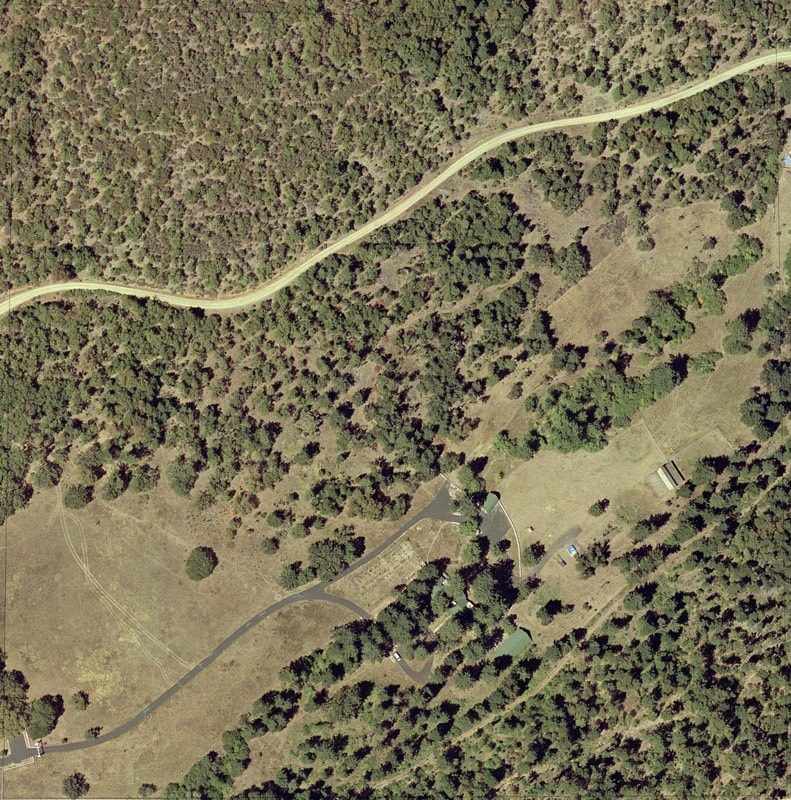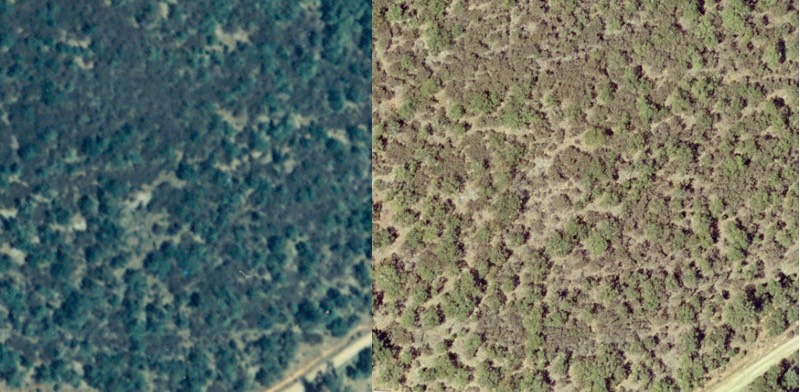We bought Gargoyle Gulch on April 15th, 1996 -- before the previous picture was taken. But we didn’t move in until July 1996, after that photo was taken. We set to work restoring the land. It takes a lot longer to build things up than to tear them down. You can see some changes in this photo:

The first change I’ll point out is in the manzanita forest north of the dirt road. Look closely and you’ll see that it’s broken up, somewhat more open than in times past. That’s because we spent something like $11,000 having it cleared for reforestation efforts. In its earlier state, it was impossible to reforest the land because it was a dense mass of manzanita and poison oak. The brush was simply too thick to penetrate. Here’s a before and after shot giving you an idea of the change:
This was hard, tough work; these guys spent two or three weeks working in the August heat with chainsaws, cutting and piling manzanita. They had to have their chains sharpened every day -- that’s how tough manzanita is. And that December, they came back and planted 4,000 seedlings in that area. The next summer, all but around 20 of the seedlings died, despite the fact that I hauled hoses all the way up to that area and painstakingly watered the seedlings by hand. There were two reasons for the death of the seedlings. The main reason was a bad drought that year that killed a lot of trees. A second reason was that the contractors had planted the seedlings improperly. We complained to the contractors but they insisted that they had planted them properly. So we got an Oregon State forestry guy come up for a meeting with them and he dug up a few dead seedlings and showed them to the contractor. The contractor reluctantly admitted error and promised to have a fellow come up that winter and plant another 2,000 seedlings. That winter somebody came up and planted, by our estimate, about 1,000 seedlings. And they were planted so badly that all but 40 or so of those seedlings died. After that, Kathy and I decided to do all the planting ourselves. Every year we ordered 100 Ponderosa Pine seedlings and hand-planted them. This is a much more tedious process than the normal method used by foresters, but it yields much higher survival rates. We have now planted about 800 seedlings this way and I’d guess that more than 400 of those are still alive.
Another change is in the area around the barn. Once again there are animals there, as indicated by the fact that all the grass has been eaten down. The cause of this is three burros. They were nice to have at first, but now they’re mostly a pain. I have to feed them every day. It’s a hassle.
Another change is the creation of Kathy’s garden. We had replaced the old electric resistance heater with a ground-based heat pump. This is the most efficient kind of system you can get. It takes heat out of the ground to heat the house. To do so, they did deep trenches and bury hundreds of feet of pipe in the trenches, then refill the trenches. For our system, they used the open land just northwest of the house. You can see the dotted lines marking the garden. We knew that, in the country it’s almost impossible to beat the moles, so we don’t plant anything directly in the ground. Instead, I made planters with heavy chicken wire bottoms. Everything is grown inside the planters where the moles can’t get to them.
You may have noticed some rust-colored spots just above the center of the photo. These are slash piles of young Douglas Firs. That area had a number of thickets of small Douglas Firs left over from the forest that had been destroyed by Mr. Grove. To improve the health of the trees, I thinned them out. They have responded very well and in another year or two I’ll probably have to do another thinning. Oh, and the rust color? That’s the color of the Douglas Fir needles as they dry out.
You might also have noticed that this aerial photo looks better than the previous ones. That’s because it is high-tech. The Bureau of Land Management (BLM) takes lots of aerial photos every five or ten years of all the lands near its own lands. Those aerial photos are available to the public for a small charge. In times past they sent you a print of the aerial photo, which I then digitized at maximum resolution. But nowadays they send you a CD-ROM with a digital copy of the image, which is much superior. That’s why the 2001 image is so much better.
